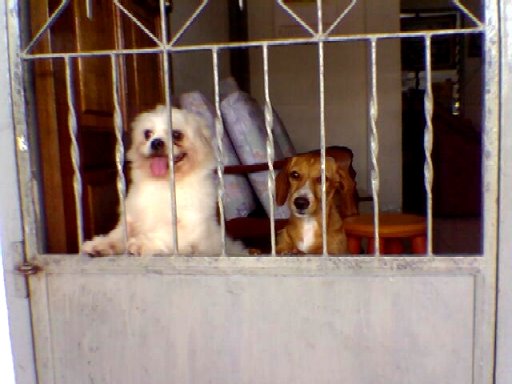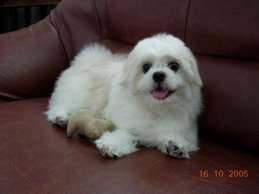Training Your Dog 101: Ten Tips On Dog Training
What dog owner doesn't want a well-behaved dog? But it doesn't just happen. Training is the only way to achieve this. In order to be able to successfully train your dog, there is some basic information you need to be aware of before you start. Here then are the top ten tips on dog training.
1. Start as soon as you bring your new puppy home. Establishing routines right away avoids problems later. For instance, if you don't want your dog to climb on the couch, sit on the floor with him. Don't bring him up on the couch with you. If you do, you are teaching him that he is allowed on the couch. This is a difficult habit to break.
2. Be firm, but fair and consistent. If you change the rules you will only frustrate and confuse your dog. So, if you don't want your dog to beg food from the table, don't ever feed him treats while you are eating.
3. Collar and lead training is one of the most important things you can do to have a well behaved dog. Start in on this as soon as possible when your puppy arrives to make training much easier and more effective.
4. Training your dog should be fun for both of you. Celebrate his accomplishments by rewarding him. Rewards can be everything from a scratch behind the ear to praise or even a small treat. He will work harder if he knows a reward is waiting for him, so you will be able to accomplish lots in a short time.
5. Be patient. Mark progress in very small steps. It takes many repetitions for the training to become a part of your dog's behavior. Compliment and reward at each step to reinforce the learned behavior.
6. There will be times when it will be necessary for you to discipline your dog. There are two important points to remember when it comes to discipline. First, don't ever order your dog to come when you are preparing to discipline him. Leave this word for positives in training. Instead go to him. Second, hitting does not have a place in dog training. If you hit your dog as a form of discipline, he will learn to be afraid of you. This will not work with dog training.
7. Whenever you start a new session of training, the first thing to do is to quickly review the behaviors that your pet has already mastered. Then as always, reward him and move on to something new.
8. Don't extend the lesson too long. When your dog seems to be losing interest or is tiring of the activity, stop the lesson, have him follow a simple command, give a small reward and then do something your dog considers fun to end the session. So, if he loves to play fetch, get that stick out and throw.
9. Teaching him commands such as "sit, stay, come, and down", first will make other lessons easier. Once he has learned these commands and responds consistently to each of them, you can then move onto more complex tricks or commands.
10. It's important for the success of your training program to only give your pet a reward when he executes a command correctly. If he knows that you will reward him whether he sits on command or not, he has no real reason to sit if he doesn't feel like sitting.
Following these tips on dog training will help you to successfully train your dog. And after all, isn't a well-behaved dog much more rewarding to have around.
1. Start as soon as you bring your new puppy home. Establishing routines right away avoids problems later. For instance, if you don't want your dog to climb on the couch, sit on the floor with him. Don't bring him up on the couch with you. If you do, you are teaching him that he is allowed on the couch. This is a difficult habit to break.
2. Be firm, but fair and consistent. If you change the rules you will only frustrate and confuse your dog. So, if you don't want your dog to beg food from the table, don't ever feed him treats while you are eating.
3. Collar and lead training is one of the most important things you can do to have a well behaved dog. Start in on this as soon as possible when your puppy arrives to make training much easier and more effective.
4. Training your dog should be fun for both of you. Celebrate his accomplishments by rewarding him. Rewards can be everything from a scratch behind the ear to praise or even a small treat. He will work harder if he knows a reward is waiting for him, so you will be able to accomplish lots in a short time.
5. Be patient. Mark progress in very small steps. It takes many repetitions for the training to become a part of your dog's behavior. Compliment and reward at each step to reinforce the learned behavior.
6. There will be times when it will be necessary for you to discipline your dog. There are two important points to remember when it comes to discipline. First, don't ever order your dog to come when you are preparing to discipline him. Leave this word for positives in training. Instead go to him. Second, hitting does not have a place in dog training. If you hit your dog as a form of discipline, he will learn to be afraid of you. This will not work with dog training.
7. Whenever you start a new session of training, the first thing to do is to quickly review the behaviors that your pet has already mastered. Then as always, reward him and move on to something new.
8. Don't extend the lesson too long. When your dog seems to be losing interest or is tiring of the activity, stop the lesson, have him follow a simple command, give a small reward and then do something your dog considers fun to end the session. So, if he loves to play fetch, get that stick out and throw.
9. Teaching him commands such as "sit, stay, come, and down", first will make other lessons easier. Once he has learned these commands and responds consistently to each of them, you can then move onto more complex tricks or commands.
10. It's important for the success of your training program to only give your pet a reward when he executes a command correctly. If he knows that you will reward him whether he sits on command or not, he has no real reason to sit if he doesn't feel like sitting.
Following these tips on dog training will help you to successfully train your dog. And after all, isn't a well-behaved dog much more rewarding to have around.
About the Author:
A comfortable bed is a great way to show your dog that you appreciate his hard work during your training sessions. Dogs love to feel warm and cozy. A heated dog bed is the ultimate in comfort. Some dogs prefer the soft padded cushion and the bolster which doubles as a pillow in a bolster dog bed.














.jpg)






.jpg)

0 comments:
Post a Comment